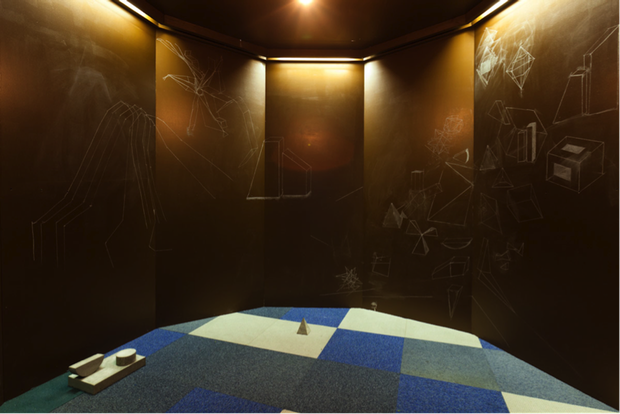Interview with Anne Hardy
For more than a decade, London-based artist Anne Hardy has exhibited photographs of interior spaces she has constructed in her studio. In her new exhibition at Maureen Paley in London, on view through May 26, she has included freestanding sculptural installations alongside her photographs. Brian Sholis spoke with Hardy by e-mail about this development in her art.
Brian Sholis: For years you’ve created objects and built environments to photograph, yet this is one of the first times you’ve allowed exhibition viewers to have access to these materials and spaces. Can you speak about the privacy of the studio and the decision to exhibit things that had otherwise gone unseen by the public?
Anne Hardy: In 2011 I was an artist-in-residence at the Camden Arts Centre. Though private, the studio itself felt like a gallery, and sits alongside the venue’s gallery spaces. My ambition for the residency was to build one of the “sets” I construct for my photos, but also to have the chance to evaluate one of these structures outside the context of my own studio, and to invite others to see it as well. In a way, the time at Camden was transitional for me, and allowed me to connect two environments that had previously been separate in my practice—the private space of the studio and the public space of the exhibition. I had become increasingly interested in the structures I was building in order to realize my images, and wanted to think about what further role—if any—they might play in my work, or if they (or something like them) might in fact be the work. They have physical and material qualities, and allow for the viewer’s movement through them, that I cannot replicate with photographs.
Working in the gallery for a month before this exhibition felt a bit like a second residency, but with the added clarity of the space being given over to an exhibition at the end. In this exhibition there are three sculptural spaces—rooms you can enter that have not been used to make the photographs that they are exhibited alongside. They are independent sculptures, built specifically to fit the space in a particular way. For example, it’s important to me that you do not see the doors of two of them as you walk into the gallery, but must walk around them in order to access their interiors.
BJS: So these constructions are no longer “process materials.”
AH: Well, last year, as I was preparing for my show at the Secession in Vienna and its accompanying book, I began to think about how I could open up other ways into my work without presenting work-in-progress studio shots. The small photograph Shelf (2013) is a product of this. It’s one of several smaller images meant to act as a detail without actually being a detail of any particular work—it’s like a newly made potential detail. The two larger photographs in the show at Maureen Paley also use materials from my working process in new ways.
It’s exciting to finally exhibit physical spaces that people can enter. I have thought about it for a long time, and wanted to do it only at a point when I felt they would not be seen as subsidiary to the images. I’m happy to see the photographs and the structures face one another equally and hold their own ground. I now feel like I can explore the relationships between environments, images, and objects.
BJS: Was your years-long desire to find a way to achieve this balance intrinsic to your studio practice? Or was it fostered by the relationship between images and objects in the culture at large? Or both?
AH: I am interested in the indeterminate state I perceive in cast-off materials and objects—in rubbish. Something that appears unimportant can become significant and meaningful for an individual who chooses to invest time with it. I think these things can create a space for the imagination that is quite free. I want this quality to be intrinsic to the materials I use in my work, and in the relationship between physical spaces and the images. What previously was captured by single images can now, I hope, open out across an entire exhibition of works.
BJS: How does the fact that your photographs nearly always depict a shallow space, bounded at the back by a wall, play into this? Are you attempting to create an “inhabitable” space for this free play of thought?
AH: Yes, in recent images such as Rift, Script, and Notation I really concentrated on making image-spaces that are less interpretable, that are flatter or more confusing in their spatial layout, in order to open up how the image could be read. I want viewing these works to be in part about the process of reading them, coming to understand them.
BJS: And is making an image as much about the “process of reading” as about the actual space depicted a way of creating a metaphorical link between the construction of space and the “construction” of a self? Put more simply, to what extent are the spaces you photograph meant to be psychologically charged?
AH: I hope that the process of comprehending the new photographs is less about resolving a depiction of a particular kind of place, in which you say “Oh, this reminds me of that” and in so doing distance yourself from it. Instead I hope the ambiguity will cause viewers to be more aware of what they are projecting onto the image. The sculptural works take this one step further by involving you physically with the work—you can literally step into them.
I want the psychological charge of the work to come from this combination of myself, the viewer, and the imagined potential of these spaces and objects.
























